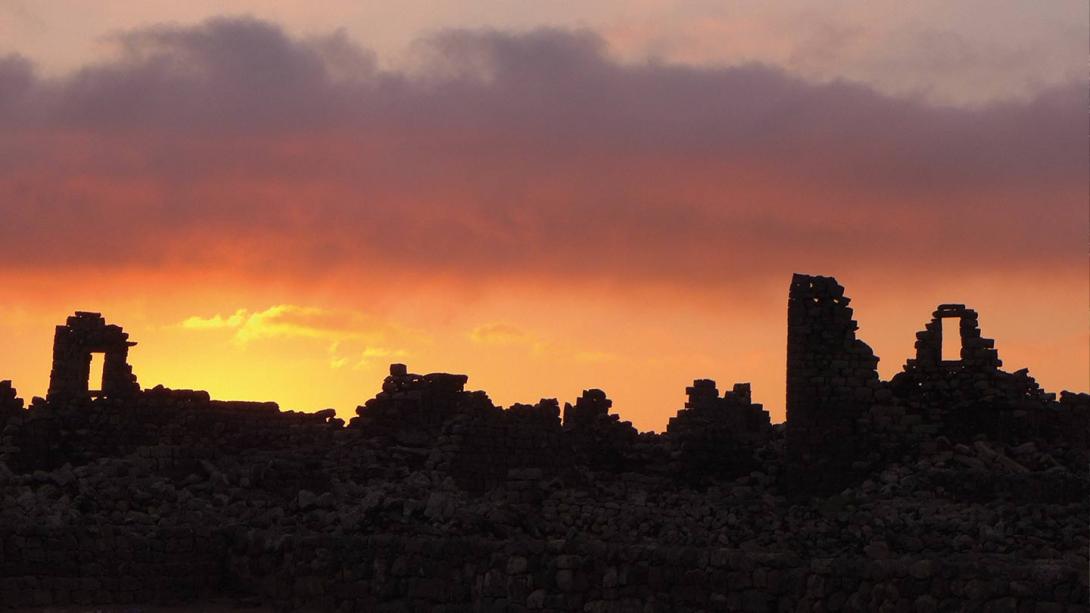Rise of the dead ruins

From little-known ruins inhabited by Bedouin to a potential UNESCO World Heritage Monument, Umm al-Jimal has slowly risen from obscurity to distinction.
Behind the efforts to literally remove the dust from this ancient village is Calvin history professor emeritus Bert de Vries ’60, who has spent nearly five decades directing the Umm el-Jimal Project (project name differs from the village name) in northern Jordan (Google Maps link).
bodyimage2With a background in engineering and ancient literature and history, de Vries was first awarded a grant to map the site in 1972.
“No one was doing anything there at that time,” said de Vries. “Nobody knew what to do with it. When I came there, it was a dead site.”
Remarkably preserved, the 2,000-year-old site garnered de Vries’ interest, leading to nearly 50 years of engagement by de Vries and many others—including nearly 200 Calvin students—and the development of a foremost antiquities site.
For his commitment, de Vries was recently recognized with the King Abdullah Medal of Excellence, the highest level of recognition of quality in Jordan.
“Bert de Vries is an unassuming scholar, who has made a tremendous impact beyond the bounds of Calvin, both within the international community of Near Eastern Archaeology and within the local community of Umm al-Jimal, Jordan,” said Darrell Rohl, the current director of Calvin’s archaeology program. “Bert has poured his blood, sweat, and tears into both the archeological work and the local community development work. His work over so many decades is what made me so passionate about joining the Calvin faculty and the Umm el-Jimal Project.”
De Vries was bestowed the honor at the opening ceremony of the Interpretive and Hospitality Center at Umm al-Jimal this past summer.
bodyimage1The center, which renders the site more welcoming to visitors, is part of an endeavor to create a local tourism economy, thereby strengthening the community bytraining its members as guides and promoting goods and services at the neighboring town.
A museum with artifacts and historical information about the site, an accessible walking tour with interpretive signs, and trained local guides all add value to a visit to Umm al-Jimal, which was the most prominent town in the Hauran region at its time.
bodyimage3From the project’s inception, de Vries has sought to make it a resource for the local community, which was not previously benefiting from the site.
In fact, the local residents had settled in the ancient ruins after World War I. Then when they were excluded from the site in 1970, they built their own village of concrete houses adjacent to the ruins.
bodyimage4“My principle from the beginning was to include the local people,” said de Vries, who rents a house in the village. “I always felt like they should be considered part of the team. We usually hired 20–30 local people, and I’ve always felt that they should understand what they’re doing and why.
“The question ‘What is the role of heritage and what are the rights of people?’ has been central to this project. The term we use is ‘community archaeology.’”
Other Calvin alumni have supported those efforts as well, among them Paul Christians ’03 and Jeff DeKock ’01, who helped with visual documentation of the site and making those resources available online. Elizabeth Osinga ’07 wrote her PhD on Umm al-Jimal pottery and is currently director of the project’s publications. Bert’s daughter Jenna de Vries Morton ex’85 has contributed much to the design and fundraising for the Interpretive Center, community education, and tourism promotion. And Bert’s wife, Sally Northouse de Vries ’62, has been a key staff member and partner on all the excavation seasons, especially working as administrator on field seasons and a designer of the heritage display in the new museum.
The future “life” of the site depends on the implementation of a site management plan, which de Vries is writing with the Department of Antiquities, and the sustained involvement of the community in visitor services and site preservation.
“We’re being helped by the notion that archaeology is more than digging holes in the ground, which has become universal,” said Bert de Vries. “People are seeing this [engaging local communities] as a worldwide movement, and it’s gratifying that we’re making a contribution to that.”
callout1





